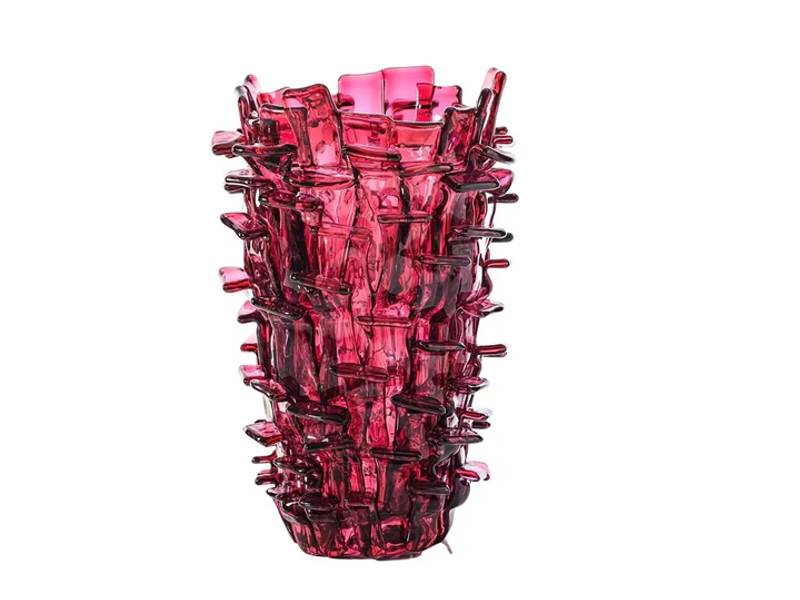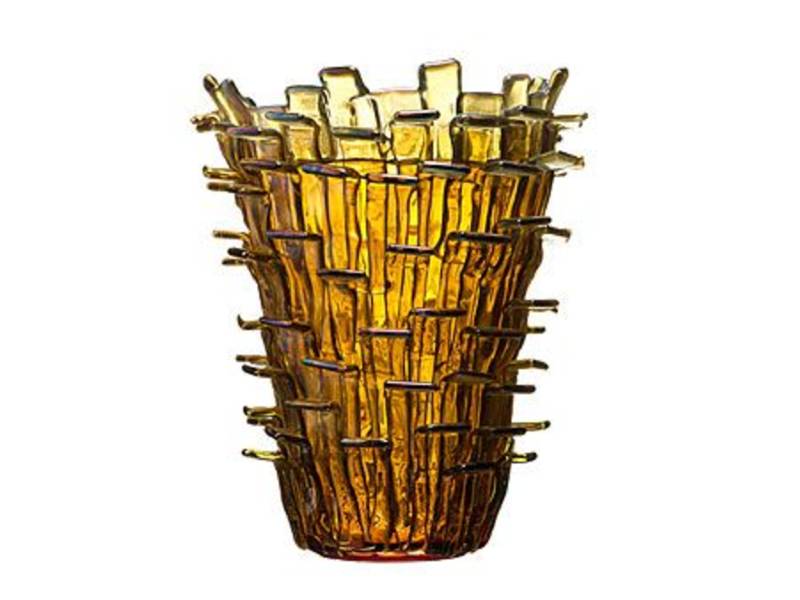glassmaking technique devised by Fulvio Bianconi, the most innovative and
suggestive of the twentieth century: small rectangular glass strips applied one
on top of the other, on a base of a truncated cone which has been blown and
worked by hand. Iridescent green and aquamarine, iridescent sand and red meet
on a contour that seems to have always been in existence, yet it is dated 1989.
Item number: 552.00.
Collection: Authors collections. Limited Edition 99pz. Art direction studio Marco Piva
Author: Fulvio Bianconi | 1989
Year: 2023
Material: Murano glass.
Colour: Magenta
Size: H: 31cm; D:22.
Weight: 6 Kg.
This work by Fulvio Bianconi stems from the most innovative glassmaking technique in the 1900s: thin rectangular strips of glass are placed one on top of the other and then hand-applied to a conical base made from blown glass.
Fulvio Bianconi: settled in Milan and collaborated throughout his life with the Milanese publishing houses Mondadori, Bompiani and Garzanti as a graphic designer and illustrator. He also dedicated himself to painting frescos in the Galtrucco stores and in the Pavilions of the Milan Trade Fair. These occupations were combined with his constant passion for glass. In 1946, he repeatedly went to Murano to study the art of glassmaking. Here he met Paolo Venini, a decisive meeting for both of them: this young man’s creativity marked a breaking point in the history of VENINI. Vehement research and experimentation with new glassmaking techniques, which often implies re-elaborating very ancient skills, is a constant in Fulvio Bianconi’s work. New movements and colours emerge in the glass and retrace the bond between the history of Murano and a great modernity. This contamination between craft and creative flair has given rise to several iconic works, such as the Figure della Commedia dell’Arte, the Tiepolo, the Fazzoletto, the Sirene and the Pezzati.



 Austria
Austria Azores Islands and Madeira
Azores Islands and Madeira Belgium
Belgium Bulgaria
Bulgaria Cipro
Cipro Croatia
Croatia Czech Republic
Czech Republic Denmark
Denmark Estonia
Estonia Finland
Finland France
France Germany
Germany Greece
Greece Hungary
Hungary Irland
Irland Latvia
Latvia Lithuania
Lithuania Luxembourg
Luxembourg Malta
Malta Monaco
Monaco Netherlands
Netherlands Poland
Poland Portugal
Portugal Romania
Romania Slovakia
Slovakia Slovenia
Slovenia Spain
Spain Sweden
Sweden Albania
Albania American Samoa
American Samoa Andorra
Andorra Anguilla
Anguilla Antigua and Barbuda
Antigua and Barbuda Argentina
Argentina Aruba
Aruba Australia
Australia Bahamas
Bahamas Bahrein
Bahrein Bangladesh
Bangladesh Barbados
Barbados Belize
Belize Bermuda
Bermuda Belarus
Belarus Bolivia
Bolivia Bosnia Erzegovina
Bosnia Erzegovina Brazil
Brazil Brunei Darussalam
Brunei Darussalam Canada
Canada Canary Islands
Canary Islands Cayman Islands
Cayman Islands Chile
Chile China
China Colombia
Colombia Costa Rica
Costa Rica Dominica
Dominica Dominican Republic
Dominican Republic Ecuador
Ecuador Egypt
Egypt El Salvador
El Salvador Ex Yugoslavia
Ex Yugoslavia Faroe Islands
Faroe Islands Fiji
Fiji French Guyana
French Guyana French Polynesia
French Polynesia Gibiltar
Gibiltar Grenada
Grenada Groenlandia
Groenlandia Guadalupa
Guadalupa Guam
Guam Guatemala
Guatemala Guyana
Guyana Haiti
Haiti Honduras
Honduras Hong Kong
Hong Kong India
India Indonesia
Indonesia Iceland
Iceland Israel
Israel Jamaica
Jamaica Japan
Japan Kuwait
Kuwait Macao
Macao Macedonia
Macedonia Malaysia
Malaysia Maldives
Maldives Martinica
Martinica Mexico
Mexico Micronesia
Micronesia Moldova
Moldova Montserrat
Montserrat New Caledonia
New Caledonia New Zeland
New Zeland Norway
Norway Oman
Oman Pakistan
Pakistan Palau
Palau Panama
Panama Paraguay
Paraguay Peru
Peru Philippines
Philippines Puerto Rico
Puerto Rico Qatar
Qatar Russia
Russia Saint Kitts and Nevis
Saint Kitts and Nevis Saint Vincent and Grenadine
Saint Vincent and Grenadine Samoa
Samoa Saint Lucia
Saint Lucia Saudi Arabia
Saudi Arabia Singapore
Singapore Sri Lanka
Sri Lanka South Africa
South Africa South Corea
South Corea Suriname
Suriname Switzerland
Switzerland Taiwan
Taiwan Thailand
Thailand Trinidad and Tobago
Trinidad and Tobago Turkey
Turkey Ukraine
Ukraine United Arab Emirates
United Arab Emirates Uruguay
Uruguay USA
USA Virgin Islands UK
Virgin Islands UK Virgin Islands USA
Virgin Islands USA



